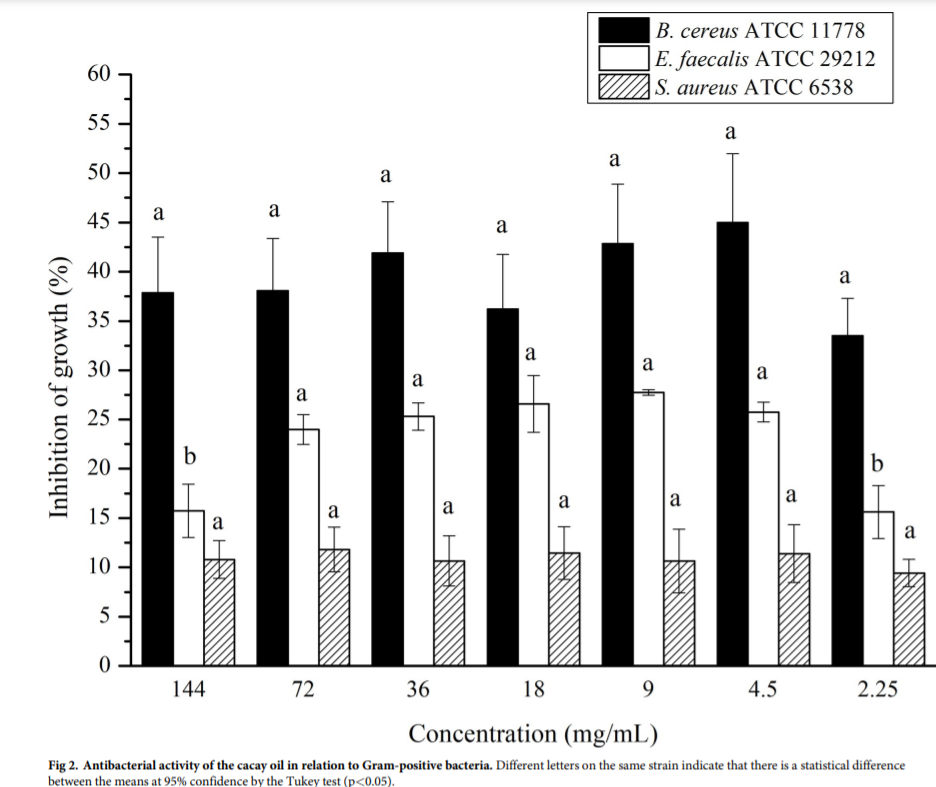The results of Figure 2 highlights the antibacterial activity of cacay oil. Since the method involves adding cacay oil to a "broth" medium, it can be inferred that cacay oil is hydrophilic
The results of Figure 2 highlights the antibacterial activity of cacay oil. Since the method involves adding cacay oil to a "broth" medium, it can be inferred that cacay oil is hydrophilic
Human Anatomy & Physiology (11th Edition)
11th Edition
ISBN:9780134580999
Author:Elaine N. Marieb, Katja N. Hoehn
Publisher:Elaine N. Marieb, Katja N. Hoehn
Chapter1: The Human Body: An Orientation
Section: Chapter Questions
Problem 1RQ: The correct sequence of levels forming the structural hierarchy is A. (a) organ, organ system,...
Related questions
Question
The results of Figure 2 highlights the antibacterial activity of cacay oil. Since the method involves adding cacay oil to a "broth" medium, it can be inferred that cacay oil is hydrophilic. Agree or Not?
![Antibacterial activity in the sample with higher values of polyunsaturated fatty acids was per-
formed according to the methodology described by the Clinical and Laboratory Standards
Institute (CLSI) [23], with modifications. Six potentially pathogenic bacterial strains were
tested: three Gram-negative (Escherichia coli ATCC 25912, Pseudomonas aeruginosa ATCC
27853, and Salmonella paratyphi ATCC 14028) and three Gram-positive (Bacillus cereus
ATCC 11778, Enterococcus faecalis ATCC 29212, and Staphylococcus aureus ATCC 6538).
The microorganism suspension in Mueller Hinton (MH) broth (Merck, Darmstadt, Ger-
many) was added to different sample concentrations (2.25–144.00 mg/mL) dissolved in 1% (v/
v) tween 80 in a 96-well microplate. The microplates were then incubated at 35°C under shak-
ing at 200 rpm (Quimis, Q816M20, Diadema, Brazil). The optical density at 595 nm was deter-
mined at times 0 and 24 h.
Wells containing MH broth, microorganisms, and saline solution 0.9% with 1% tween 80
were considered as positive growth control (100% bacterial growth). Vancomycin (0.4 mg/
ml) was added to the Gram-positive and gentamicin (0.3 mg/mL) to the Gram-negative bacte-
ria for the microbial sensibility profile control.
The inhibition percentage of bacterial growth was calculated according to Eq 1:
[AAbs- AAbsample
x 100
AAbs
Inhibition of bacterial growth (%) =
(1)
Where AAbspc represents the absorbance variation in the positive control (100% bacterial
growth), and Aabs,ample the absorbance variation in the sample.](/v2/_next/image?url=https%3A%2F%2Fcontent.bartleby.com%2Fqna-images%2Fquestion%2F830dd9ad-a376-4f69-893d-60910a068f7d%2F1606cdd1-7172-4124-97d6-45032f10f8d8%2Fin0pob_processed.png&w=3840&q=75)
Transcribed Image Text:Antibacterial activity in the sample with higher values of polyunsaturated fatty acids was per-
formed according to the methodology described by the Clinical and Laboratory Standards
Institute (CLSI) [23], with modifications. Six potentially pathogenic bacterial strains were
tested: three Gram-negative (Escherichia coli ATCC 25912, Pseudomonas aeruginosa ATCC
27853, and Salmonella paratyphi ATCC 14028) and three Gram-positive (Bacillus cereus
ATCC 11778, Enterococcus faecalis ATCC 29212, and Staphylococcus aureus ATCC 6538).
The microorganism suspension in Mueller Hinton (MH) broth (Merck, Darmstadt, Ger-
many) was added to different sample concentrations (2.25–144.00 mg/mL) dissolved in 1% (v/
v) tween 80 in a 96-well microplate. The microplates were then incubated at 35°C under shak-
ing at 200 rpm (Quimis, Q816M20, Diadema, Brazil). The optical density at 595 nm was deter-
mined at times 0 and 24 h.
Wells containing MH broth, microorganisms, and saline solution 0.9% with 1% tween 80
were considered as positive growth control (100% bacterial growth). Vancomycin (0.4 mg/
ml) was added to the Gram-positive and gentamicin (0.3 mg/mL) to the Gram-negative bacte-
ria for the microbial sensibility profile control.
The inhibition percentage of bacterial growth was calculated according to Eq 1:
[AAbs- AAbsample
x 100
AAbs
Inhibition of bacterial growth (%) =
(1)
Where AAbspc represents the absorbance variation in the positive control (100% bacterial
growth), and Aabs,ample the absorbance variation in the sample.

Transcribed Image Text:|B. cereus ATCC 11778
|E. faecalis ATCC 29212
|S. aureus ATCC 6538
60 1
55 -
a
a
50
a
a
a
45
a
* 40
a
35
a
30
a
a
a
a
25
b
b
20
a
a
a
a
15 -
a
a
10
5
144
72
36
18
9.
4.5
2.25
Concentration (mg/mL)
Fig 2. Antibacterial activity of the cacay oil in relation to Gram-positive bacteria. Different letters on the same strain indicate that there is a statistical difference
between the means at 95% confidence by the Tukey test (p<0.05).
Inhibition of growth (%)
Expert Solution
This question has been solved!
Explore an expertly crafted, step-by-step solution for a thorough understanding of key concepts.
Step by step
Solved in 2 steps

Recommended textbooks for you

Human Anatomy & Physiology (11th Edition)
Biology
ISBN:
9780134580999
Author:
Elaine N. Marieb, Katja N. Hoehn
Publisher:
PEARSON

Biology 2e
Biology
ISBN:
9781947172517
Author:
Matthew Douglas, Jung Choi, Mary Ann Clark
Publisher:
OpenStax

Anatomy & Physiology
Biology
ISBN:
9781259398629
Author:
McKinley, Michael P., O'loughlin, Valerie Dean, Bidle, Theresa Stouter
Publisher:
Mcgraw Hill Education,

Human Anatomy & Physiology (11th Edition)
Biology
ISBN:
9780134580999
Author:
Elaine N. Marieb, Katja N. Hoehn
Publisher:
PEARSON

Biology 2e
Biology
ISBN:
9781947172517
Author:
Matthew Douglas, Jung Choi, Mary Ann Clark
Publisher:
OpenStax

Anatomy & Physiology
Biology
ISBN:
9781259398629
Author:
McKinley, Michael P., O'loughlin, Valerie Dean, Bidle, Theresa Stouter
Publisher:
Mcgraw Hill Education,

Molecular Biology of the Cell (Sixth Edition)
Biology
ISBN:
9780815344322
Author:
Bruce Alberts, Alexander D. Johnson, Julian Lewis, David Morgan, Martin Raff, Keith Roberts, Peter Walter
Publisher:
W. W. Norton & Company

Laboratory Manual For Human Anatomy & Physiology
Biology
ISBN:
9781260159363
Author:
Martin, Terry R., Prentice-craver, Cynthia
Publisher:
McGraw-Hill Publishing Co.

Inquiry Into Life (16th Edition)
Biology
ISBN:
9781260231700
Author:
Sylvia S. Mader, Michael Windelspecht
Publisher:
McGraw Hill Education